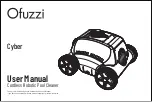
To ensure reliable measuring and control, the
sample water must be free from air bubbles.
1.
Set a flow of 20 ... 60 l/h using the stopcock (read-off at the
top edge of the float).
2.
Check the hydraulic leak-tightness of the system (escaping
liquid, continuous air bubbles in the in-line probe housing, ...)
ð
Tighten the threaded connectors if necessary.
1.
Have a collecting vessel at the ready
Open the sampling tap
2.
If water flows out of the sampling tap, the system is not under
negative pressure and is working correctly
If air is drawn in, this means that there is
negative pressure in the system. In this case,
throttle the valve at the point at which the
sample water pipe enters the filtration circuit -
the pressure should not exceed 2 bar.
3.
Use the stopcock on the sample water drain to finely adjust
the system
5.2.2 Sensors
Observe the operating instructions for the sensors.
1.
Close the shut-off valves upstream and downstream of the
in-line probe housing
2.
Remove the transparent protective cap from the ball-shaped
end of the pH sensor
3.
Manually screw both the pH sensor and the redox sensor into
separate threaded holes on the in-line probe housing. Then
carefully tighten using an SW 17 open-ended spanner until
the threaded connector is tight
4.
Testing the sensors' hydraulic installation: Adjust the flow
using the shut-off valve to 20... 60 l/h
ð
Check whether the threaded connectors on the in-line
probe housing are tight.
Testing the hydraulic installation of
the metering system:
Check the system for negative pres‐
sure
Assembly
18















































